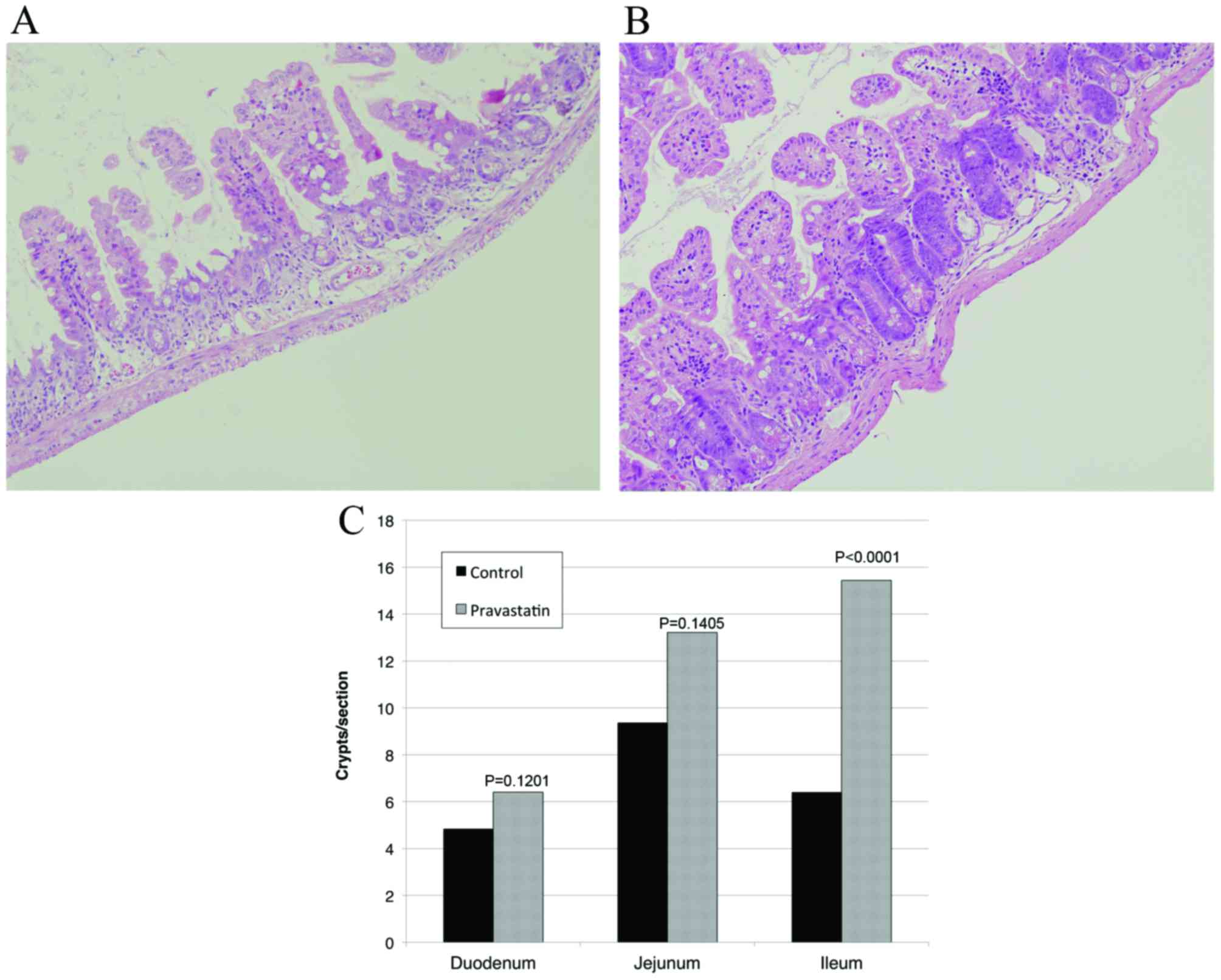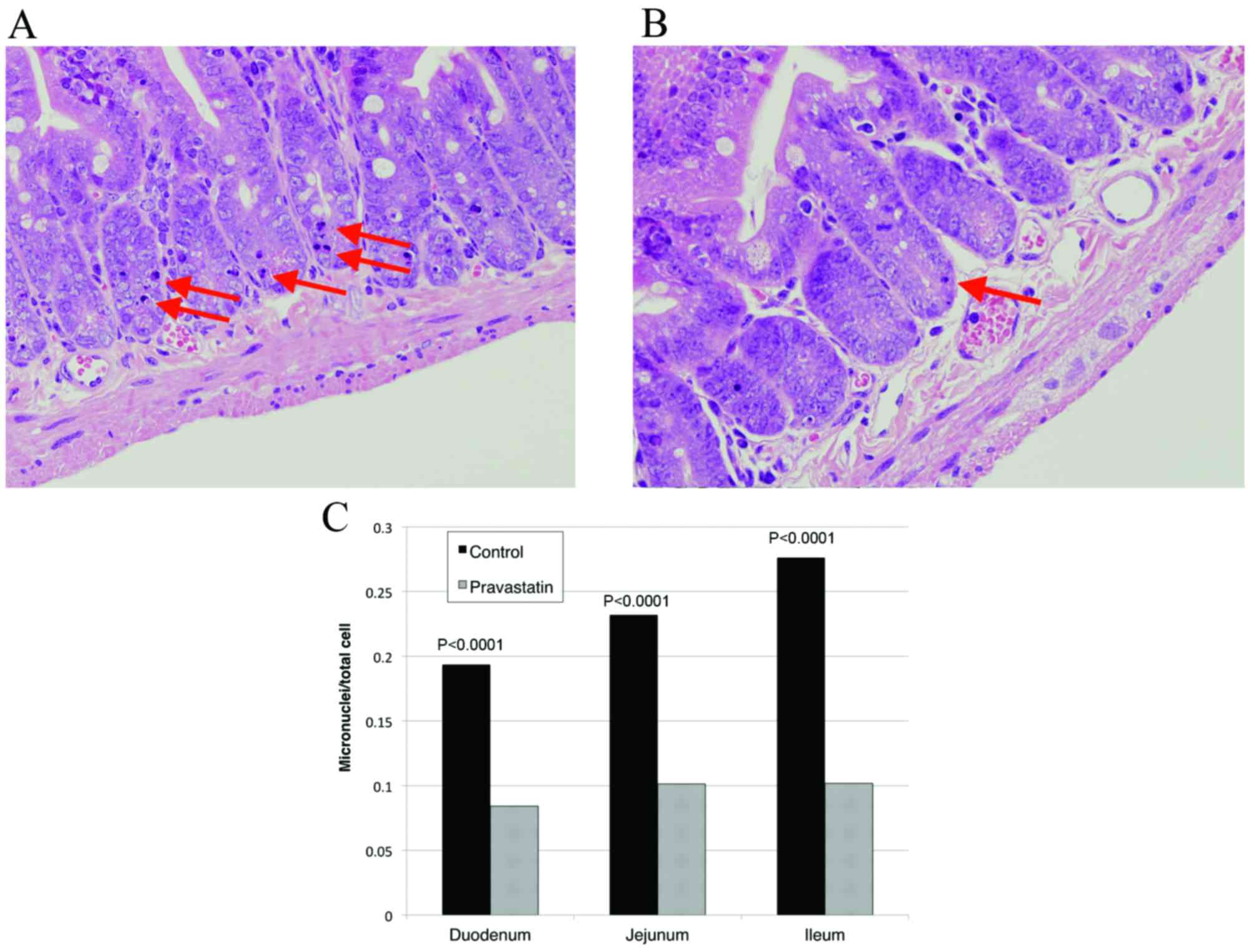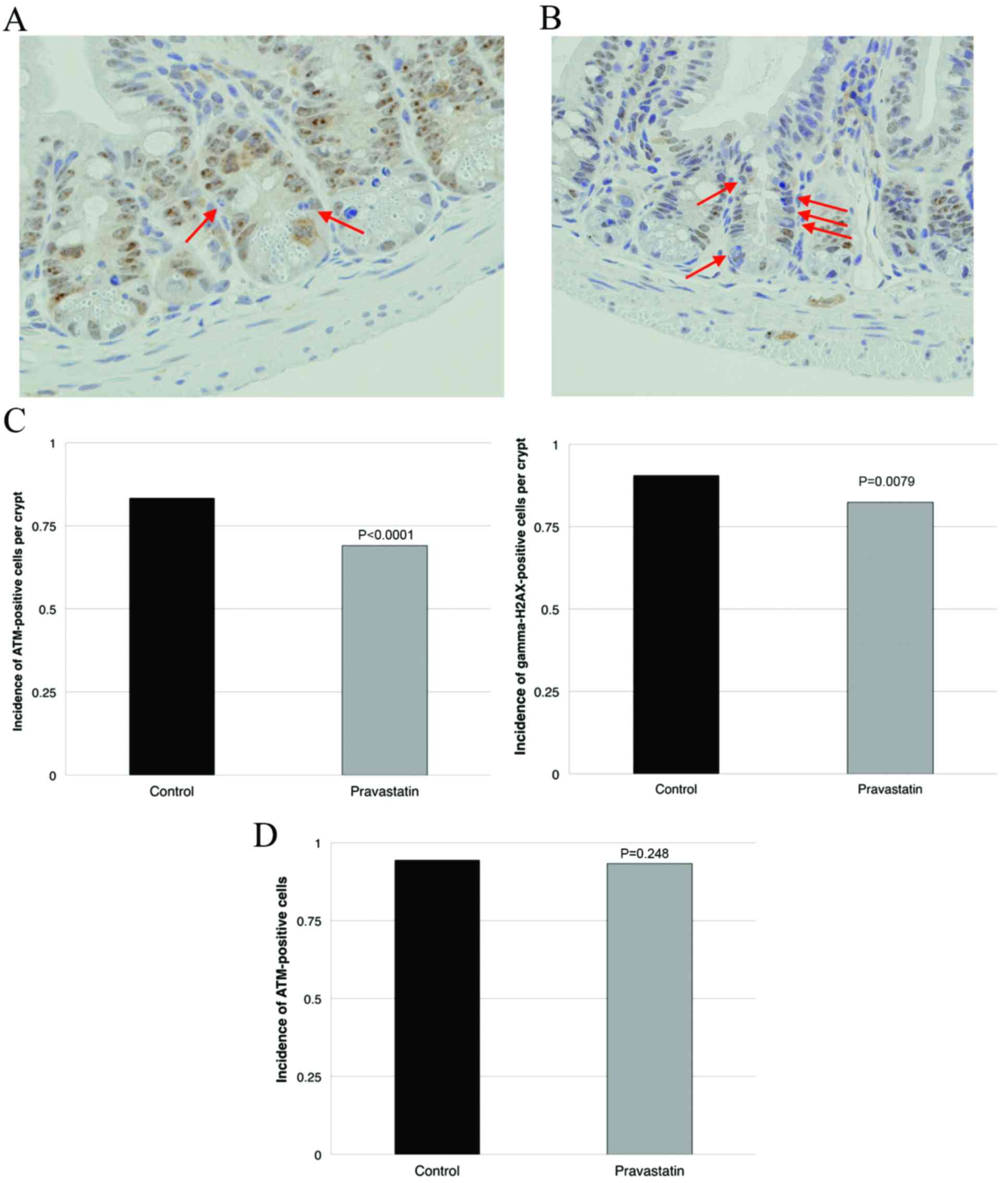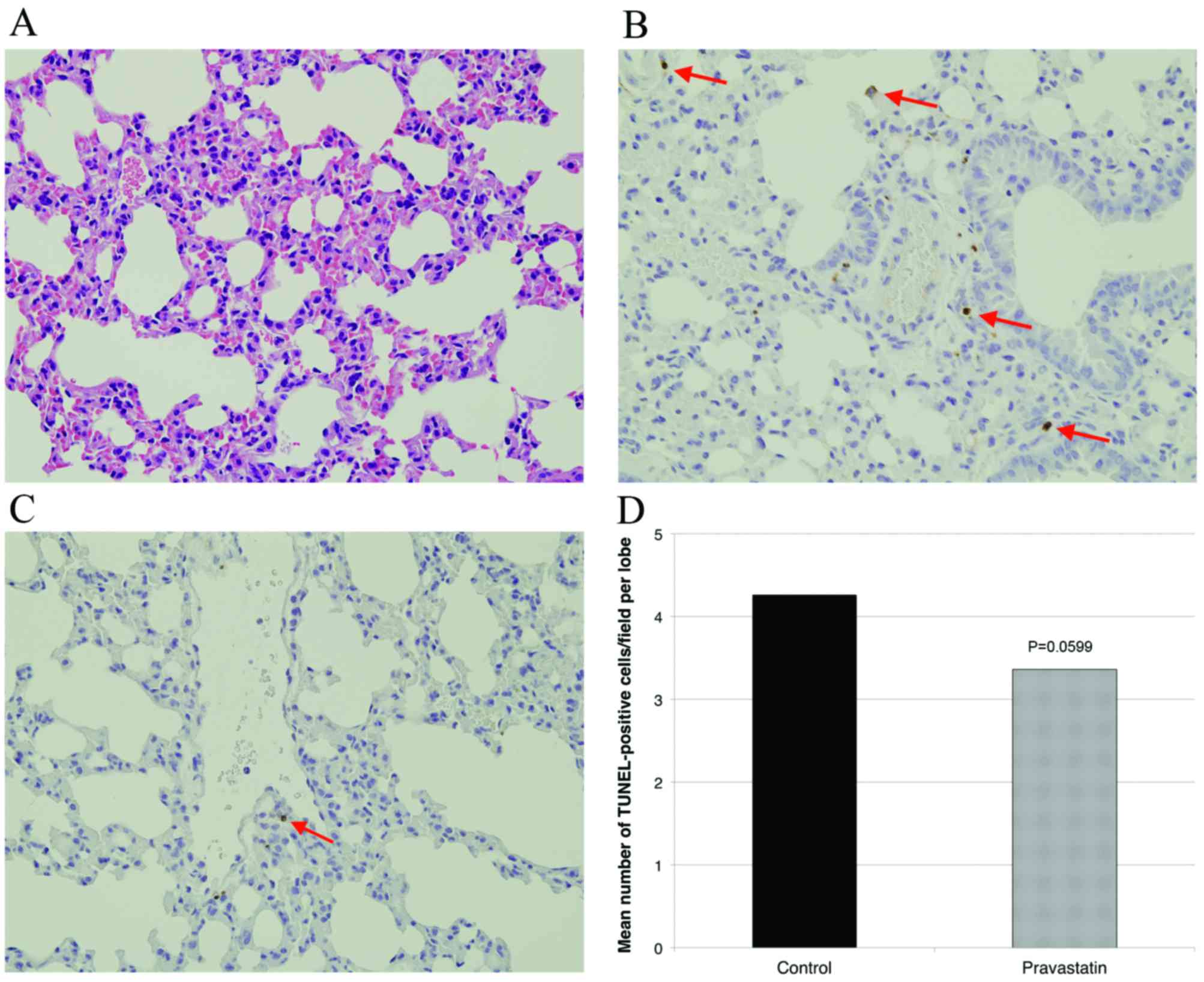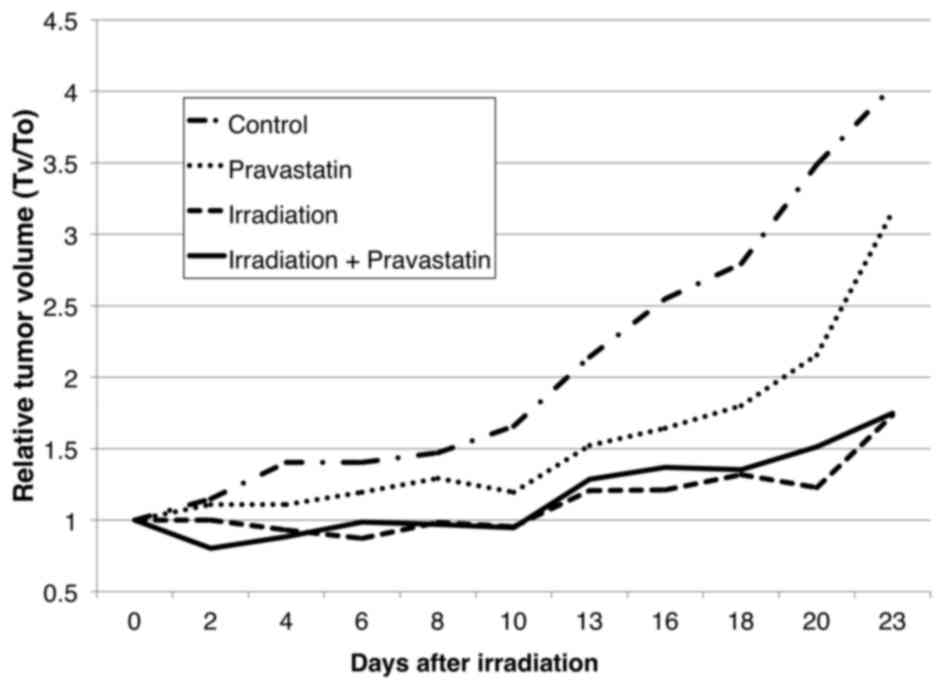Introduction
Radiotherapy plays an important role in cancer
treatment. Radiation-induced gastrointestinal disorders are the
most common adverse events associated with the treatment of
malignancies affecting the abdomen and pelvis (1). These disorders often reduce the
patient's quality of life during treatment and sometimes limit the
dose of radiotherapy that can be used to treat abdominal and pelvic
tumors (2). Amifostine has been
recommended for preventing severe radiation-induced toxicities and
is the only radioprotectant that has been approved by the US Food
and Drug Administration (3).
However, the daily use of amifostine is limited because of its
hematological and gastrointestinal toxicity (4).
Pravastatin, an inhibitor of
3-hydroxy-3-methyl-glutaryl- conenzyme A (HMG-CoA) reductase, is
widely used to treat hypercholesterolemia and has been reported to
have a therapeutic applicability in a range of inflammatory
conditions (5,6). Statins have previously been reported to
have beneficial effects on radiation-induced toxicities, and
numerous studies have demonstrated the anti-inflammatory effects of
pravastatin following radiation exposure (7–15).
Previous clinical data has shown that the use of statins reduces
acute gastrointestinal symptoms following radical pelvic
radiotherapy (15). Lovastatin has
been reported to accelerate DNA repair after radiation exposure
(11,12). The radioprotective effects of statins
are due to the inhibition of several inflammatory kinases,
including Rho and Rho-associated protein kinases (7,8,13). However, the mechanism of the radio
protective effect of statins remains unclear. In addition, only a
few experimental studies have reported the radioprotective effects
of pravastatin and these remain to be completely elucidated
(7–10).
The aim of the present study was to assess the
radioprotective effects of pravastatin in normal tissues using an
animal model.
Materials and methods
Animals and reagents
Male C57BL/6 J mice, aged 7–8 weeks and weighing
20–28 g, were obtained from Charles River Laboratories Japan, Inc.
(Yokohama, Japan) and used in the present study. All mice were
acclimated for 7 days. They were housed 3 to 5 per cage
(temperature, 23±2°C; humidity; 55±10%; 12-h light/dark cycle) and
fed with a laboratory rodent pellet formula and tap water ad
libitum. All of the animal experiments described herein were
approved by the Hyogo College of Medicine (Nishinomiya, Japan)
Institutional Animal Care and Use Committee (approval numbers:
13–047 and 14–065). Pravastatin sodium salt hydrate was obtained
from Sigma-Aldrich Japan K.K. (Tokyo, Japan). Pravastatin was
orally administered at 30 mg/kg body weight in drinking water 24
and 4 h prior to irradiation. The same volume of water with no
drugs was administered to the control group. Mice were irradiated
at a dose of ~200 cGy/min using a 150 kVp X-ray unit, Hitachi
MBR-1520 (20 mA, 150 kV; Hitachi Ltd., Tokyo, Japan). For
dosimetry, a probe connected to an electrometer system was placed
close to the target site. Peritoneal injection of sodium
pentobarbital (Somnopentyl, Kyoritsu Seiyaku, Tokyo, Japan) at ~45
mg/kg body weight was used throughout the experiment for
anesthesia.
Intestinal crypt stem cell survival
assay
The detailed procedure for analysis of intestinal
crypt cell survival following irradiation has been described
previously (16). Each treatment
group included four mice. A total body irradiation of 15 Gy was
delivered in a single fraction and the mice were sacrificed 3.5
days after irradiation by peritoneal injection of sodium
pentobarbital (>200 mg/kg body weight). The duodenum, jejunum,
and ileum were removed, fixed and stained with hematoxylin and
eosin (H&E). Surviving crypts that had ≥10 cells in each
cross-section were counted using light microscopy. In addition, the
numbers of surviving crypts in eight intestinal slices from each
part of the intestine were counted.
Analysis of apoptosis in the
intestine
The procedure for the analysis of apoptosis in
normal intestine following irradiation has been described
previously (17,18). Each treatment group included four
mice. A total body irradiation of 2 Gy was delivered in a single
fraction. At 4 h after irradiation, the duodenum, jejunum and ileum
were removed, fixed and stained with H&E. Apoptotic cells were
defined as epithelial cells with apoptotic fragments in the
H&E-stained sections. The numbers of apoptotic cells were
quantified by counting the number of apoptotic cells in each crypt
(16 crypts per mouse). In addition, the proportion of apoptotic
cells in each crypt was expressed as the apoptotic index.
Immunohistochemistry (IHC)
The effects of pravastatin on radiation-induced DNA
double-strand breaks were investigated using IHC to detect
ataxia-telangiectasia mutated (ATM) and gamma-H2AX. Formalin-fixed
and paraffin-embedded ileum tissue sections were prepared as
described above for the analysis of apoptosis, autoclaved and then
placed in 1% H2O2. The slides were incubated
with a rabbit monoclonal antibody raised against ATM (1.96 µg/ml;
ab81292; Abcam, Cambridge, UK) or a rabbit polyclonal antibody
raised against gamma-H2AX (0.005 mg/ml; ab11174, Abcam) overnight
at 4°C. Following washing, the slides were incubated with the
secondary antibody, a biotinylated anti-mouse immunoglobulin and
horseradish-conjugated streptavidin (LSAB2; K0609; Dako Japan Co.,
Ltd., Tokyo, Japan) for ATM or a horseradish peroxidase-conjugated
anti-rabbit immunoglobulin (Histofine® Simple
StainM Mouse MAX PO (Rabbit); 414341, Nichirei
Biosciences, Inc., Tokyo, Japan) for gamma-H2AX, stained using a
diaminobenzidine kit (045-22833; Wako Pure Chemical Industries,
Ltd., Osaka, Japan), then counterstained with hematoxylin. The
number of ATM-positive cells was counted in 16 randomly selected
intestinal crypts in each mouse. In addition, the number of
gamma-H2AX-positive cells was counted in 25 villus cells from five
randomly selected villi in each mouse.
Analysis of apoptosis in the lung
The detailed procedure used for this analysis has
been described previously (19).
Each treatment group included four mice. A total body irradiation
of 5 Gy was delivered in a single fraction and the mice were
sacrificed by peritoneal injection of sodium pentobarbital >200
mg/kg body weight 6 h after irradiation. The lungs were removed,
fixed in 10% neutral buffered formalin solution, then stained with
H&E. DNA fragmentation was examined histologically using
terminal deoxynucleotidyl transferase (TdT)-mediated d-UTP nick end
labeling (TUNEL). The ApoTag Kit (S7100; Merck Millipore,
Billerica, MA, USA) was used for TUNEL labeling. Paraffin sections
(thickness, ~3 µm) were deparaffinized and rehydrated through
graded ethanol up to distilled water. Tissues were digested using
proteinase K (164-14004; Wako Pure Chemical Industries, Ltd.),
placed in 2% H2O2, then rinsed with
phosphate-buffered saline (PBS, S3024; Dako Japan Co., Ltd.).
Sections were then coated with TdT enzyme and incubated at 37°C for
30 min. After several washes in a stop buffer (S7100; EMD
Millipore, Billerica, MA, USA) at 37°C for 30 min, an
anti-digoxigenin-peroxidase antibody (S7100; EMD Millipore) was
applied to the sections. Following subsequent washes with PBS and
staining with DAB staining solution (045-22833; Wako Pure Chemical
Industries, Ltd.), the lung sections were counterstained with
hematoxylin. For quantification of TUNEL-positive cells, tissue
sections were analyzed at ×40 magnification and TUNEL positive
cells were counted. Five lobes were examined in each mouse and four
different fields were randomly analyzed per lobe. The average of
all evaluated fields in each lobe was defined as its apoptotic
score.
Analysis of the effect of pravastatin
on tumor growth rate
An xenograft tumor model was established as
described previously (20). Human
mesothelioma cells (NCI-H226) were obtained from American Type
Culture Collection (Manassas, VA, USA), were suspended in 0.10 ml
RPMI-1640 solution (Sigma-Aldrich Japan K.K.) and injected
(5×106 cells per mouse) subcutaneously into the lower
back of female nude mice (BALB/cAJcl-nu/nu; weight, 20.91±0.94 g,
age, 4 weeks old) obtained from CLEA Japan, Inc. (Tokyo, Japan).
All mice were acclimated for 7 days. They were housed 3 per cage
(temperature, 23±2°C; humidity; 55±10%; 12-h light/dark cycle) and
fed with a laboratory rodent pellet formula and tap water ad
libitum. Mice were divided into four groups as follows: Three
mice received no pravastatin and sham-irradiation; three mice
received pravastatin and sham-irradiation; six mice were irradiated
without pravastatin and six mice were irradiated after receiving
pravastatin. Treatments were started when the xenograft tumors
reached approximately 100 mm3 in volume, as calculated
by 0.5 × length × width2. For irradiation, the
tumor-bearing mice were anesthetized by peritoneal injection of
sodium pentobarbital (~45 mg/kg body weight) and placed in
individual lead boxes with the tumor protruding through a cutout
window at the rear of each box. Radiation was delivered at a dose
of 8 Gy in a single fraction. The tumor lengths and widths were
measured with calipers before treatment, and three times per week
thereafter. The tumor volume was normalized against the starting
volume.
Statistical analysis
The data are expressed as the mean with standard
deviations in parentheses, unless otherwise indicated. Data were
analyzed using a two-tailed Fisher's test or a Mann-Whitney test.
All analyses were performed using GraphPad Prism version 6.0b
(GraphPad Software, Inc., San Diego, CA, USA) and P<0.05 was
considered to indicate a statistically significant difference.
Results
Effect of pravastatin on intestinal
crypt cell survival
Radiation exposure reduced the survival of the
crypts (Fig. 1A). The pravastatin
group exhibited an increased number of viable crypts in the
intestine (Fig. 1B). The number of
viable crypts in the duodenum, jejunum and ileum was 4.84±5.90,
9.38±10.31 and 6.41±5.31 in the control group, and 6.41±7.84,
13.22±13.02 and 15.44±8.22 in the pravastatin group, respectively
(Fig. 1C). This pravastatin-induced
increase in the number of viable crypts was statistically
significant in the ileum (P<0.0001).
Effect of pravastatin on apoptosis in
the intestine
Radiation exposure induced apoptosis in the
intestinal crypts (Fig. 2A). The
pravastatin group exhibited a reduced number of apoptotic cells in
the intestine (Fig. 2B). The
apoptotic index in the duodenum, jejunum and ileum was 0.19±0.09,
0.23±0.10 and 0.28±0.10 in the control group, and 0.08±0.06,
0.10±0.07 and 0.10±0.07 in the pravastatin group, respectively
(Fig. 2C). The pravastatin group
showed significantly less apoptosis in all examined parts of the
intestine (P<0.0001).
Effect of pravastatin on
radiation-induced DNA double-strand breaks
IHC analyses found that the pravastatin group showed
fewer ATM- and gamma-H2AX-positive cells than the control group
(Fig. 3A and B). To assess the
effect of pravastatin on ATM expression in normal intestine, mice
were sacrificed 4 h after two doses of pravastatin or drinking
water and ATM-positive cells were evaluated. The proportion of
ATM-positive cells was 0.83±0.13 and 0.69±0.14 in the control and
pravastatin groups, respectively (P<0.0001; Fig. 3C). The proportion of
gamma-H2AX-positive was 0.91±0.08 and 0.82±0.10 in the control and
pravastatin groups, respectively (P=0.0079; Fig. 3D). No significant difference was
observed in the incidence of ATM-positive cells following
pravastatin administration (Fig.
3E). However, no significant improvement was observed in
radiation-induced acute gastrointestinal syndrome using a murine
survival assay (21) after total
abdominal irradiation of 20 Gy in a single fraction (data not
shown).
Effect of pravastatin on apoptosis in
the lung
H&E stating revealed no apparent differences
between the lungs of irradiated mice, as compared with
un-irradiated mice (Fig. 4A). TUNEL
staining indicated apoptotic cells in the alveolus (Fig. 4B and C). The number of TUNEL-positive
cells per lobe was 4.26±1.43 in the control group and 3.36±1.89 in
the pravastatin group (P=0.060). This difference was not
statistically significant (Fig.
4D).
Effect of pravastatin on tumor growth
rate after irradiation
Pravastatin treatment had no negative impact on the
growth rates of xenograft tumors after irradiation (Fig. 5).
Discussion
Although radiotherapy provides a highly effective
treatment option for malignancies, the resulting gastrointestinal
and lung toxicities can be life-threatening and there are no
well-established treatments for these. Statins are HMG-CoA
reductase inhibitors that are widely used to treat
hypercholesterolemia; their potential radioprotective effects have
been discussed in a limited number of preclinical and clinical
studies (5–15). Clinical studies have reported that
pravastatin has anti-inflammatory effects and is a safe HMG-CoA
reductase inhibitor that is water soluble (5). However, the use of pravastatin to
reduce radiation-induced damage to normal tissue has not been
investigated thoroughly, despite its promise for use as a
radioprotectant (7–10).
Haydont et al reported that pravastatin
suppressed late radiation-induced submucosal fibrosis in the
intestine, although no differences were observed in acute
intestinal changes after radiation exposure (8,9).
However, the present study identified reproducible radioprotective
effects of pravastatin on acute radiation-induced injury in the
intestine and the lung. Late intestinal complications are common
following radiotherapy for abdominal and pelvic malignancies and
these can substantially reduce the patient's quality of life
(2). The mechanism underlying late
radiation damage involves chronic inflammation, leading to
fibrogenesis and angiopathy (22,23). The
present study focused on the acute effects of radiation exposure,
in order to clarify the radioprotective effects of pravastatin
accurately. In addition, the classical radiobiological view of
radiation-induced tissue injury as the direct consequence of DNA
damage and cell death in target cells means that the severity of
tissue damage is directly related to cell depletion during this
acute phase. Moreover, acute injury has been primarily attributed
to apoptosis of epithelial stem cells (24).
The effect of pravastatin on radiation-induced DNA
damage is less understood. Mahmoudi et al and Nübel et
al report that lovastatin accelerates DNA repair (11,12).
However, Mahmoudi et al also reports that neither the
initial nor residual levels of DNA damage are affected by this
statin (11). Data from the current
study suggested that pravastatin suppressed radiation-induced DNA
double-strand breaks and cell death in the normal intestine. These
results indicate the potential of pravastatin as an effective
radioprotectant, although further investigations should be
performed to characterize this.
Gomez et al reported that the ≥ grade 3
toxicity rates are 12% in the lung and 16% in the gastrointestinal
tract following intensity modulated radiation therapy after
extrapleural pneumonectomy for malignant pleural mesothelioma
(25). Therefore, a mesothelioma
cell line was used in this study to assess the potential use of
pravastatin to reduce radiation-induced pneumonitis and colitis in
future clinical trials. In addition, Haydont et al reported
that pravastatin does not reduce the anticancer effects of
radiotherapy in experimental models using colorectal, cervical and
prostate carcinoma cell lines (9).
Consistent with previous findings, the present study found no
negative effects of pravastatin on the response of human
mesothelioma xenograft tumors to radiotherapy (9,26).
Therefore, there was no evidence that pravastatin negatively
affected tumor treatment in these preclinical data.
Notably, pravastatin administration appeared to
delay tumor growth in vivo. Because the main aim of the
present study was to assess the potential negative effect of
pravastatin on tumor response to radiotherapy, only a small number
of animals were treated with pravastatin alone (sham-irradiated).
Statins have been reported to have anti-tumor effects and some
clinical data have supported their potential use against tumors
(26–32). However, there has only been one
randomized clinical trial studying this, which showed that the
addition of pravastatin did not improve outcomes in patients with
advanced gastric cancer (32).
Therefore, the anti-tumor effect of pravastatin alone and the
mechanism of this effect in relation to interstitial tumors (such
as mesothelioma) should be investigated prior to clinical
trials.
Previous reports have shown that the radioprotective
effects of statins are due to the inhibition of several
inflammatory kinases, including Rho and Rho-associated protein
kinases, which regulate pro-inflammatory and pro-fibrotic stress
responses, respectively (7,8,13). In
the present study, pravastatin reduced radiation-induced cell death
and the expression of ATM and gamma-H2AX; these are related to the
DNA damage responses following radiation exposure (33). In addition, the present study did not
identify any pravastatin-induced modulation of ATM that caused cell
cycle arrest. These data provide pre-clinical evidence for
pravastatin-mediated protection from DNA damage caused by
irradiation.
The present results indicated that pravastatin
administration reduced radiation-induced cell death in normal lung
tissue. The stronger radioprotective efficacy of pravastatin in the
intestine compared with the lung might be explained by the fact
that pravastatin uptake is mediated by bile acids and occurs
specifically in the liver and ileum (34). Pravastatin is administered orally and
has a good safety profile due to its water solubility and bile acid
elimination pathway. It is widely accepted in clinical practice as
a treatment for hypercholesterolemia and reportedly has a good
safety profile, although it may be associated with mild and
transient reactions (5,35). It is therefore a strong candidate for
investigation in clinical trials at the commonly used dosage.
Data from the current study suggest that a
hydrophilic statin, pravastatin, can provide protection from
radiotherapy-related toxicity in cancer patients, with no negative
effects on the tumor response to radiotherapy. Further mechanistic
pre-clinical and clinical studies should be conducted to determine
the efficacy of pravastatin and to explore its potential for
clinical application.
The present study has several limitations. Firstly,
a relatively small number of animals were used. Secondly,
pravastatin was shown to reduce radiation-induced apoptosis in the
normal lung; however, no significant differences were detected.
Thirdly, in this study, the lung was examined at a single time
point after irradiation, based on a previous report (19). However, as pravastatin is water
soluble, the metabolic pathway of pravastatin may affect the
results. Therefore, it may be necessary to confirm our results in a
study that includes a larger number of animals with multiple time
points and various radiation doses. Finally, with regard to
mechanistic experiments, IHC was used to identify the
radioprotective effect of pravastatin through the reduction of DNA
double-strand breaks. The replication of these findings in a
subsequent study based on the findings of the present study, and a
clinical study are required. In particular, upper stream of DNA
damage responses following radiation exposure including reactive
oxygen species and the affect of pravastatin on cell cycle remain
unclear. We therefore suggest that further preclinical studies with
different approaches may be required in order to fully elucidate
the potential use of pravastatin in a clinical practice.
In conclusion, pravastatin protected normal
intestine and lung tissues from radiation. The radioprotective
effect of pravastatin was associated with a reduction in the level
of radiation-induced DNA double-strand breaks. The use of
pravastatin may therefore increase the therapeutic index for
radiotherapy.
Acknowledgements
The authors appreciate the contribution of Mr.
Daisuke Nagata from the Institute of Experimental Animal Sciences,
Hyogo College of Medicine (Nishinomiya, Japan). This work was
supported by Grant-in-Aid for Young Scientists (B) (grant no.
25861134) Grant-in-Aid for Young Scientists (C) (grant no.
16K10707).
References
|
1
|
Kavanagh BD, Pan CC, Dawson LA, Das SK, Li
XA, Ten Haken RK and Miften M: Radiation dose-volume effects in the
stomach and small bowel. Int J Radiat Oncol Biol Phys. 76:(3
Suppl). S101–S107. 2010. View Article : Google Scholar : PubMed/NCBI
|
|
2
|
Lalla RV, Bowen J, Barasch A, Elting L,
Epstein J, Keefe DM, McGuire DM, Migliorati C, Nicolatou-Galitis O,
Peterson DE, et al: MASCC/ISOO clinical practice guidelines for the
management of mucositis secondary to cancer therapy. Cancer.
120:1453–1461. 2014. View Article : Google Scholar : PubMed/NCBI
|
|
3
|
Brizel DM, Wasserman TH, Henke M, Strnad
V, Rudat V, Monnier A, Eschwege F, Zhang J, Russell L, Oster W and
Sauer R: Phase III randomized trial of amifostine as a
radioprotector in head and neck cancer. J Clin Oncol. 18:3339–3345.
2000. View Article : Google Scholar : PubMed/NCBI
|
|
4
|
Jellema AP, Slotman BJ, Muller MJ, Leemans
CR, Smeele LE, Hoekman K, Aaronson NK and Langendijk JA:
Radiotherapy alone, versus radiotherapy with amifostine 3 times
weekly, versus radiotherapy with amifostine 5 times weekly: A
prospective randomized study in squamous cell head and neck cancer.
Cancer. 107:544–553. 2006. View Article : Google Scholar : PubMed/NCBI
|
|
5
|
Nakamura H, Arakawa K, Itakura H,
Kitabatake A, Goto Y, Toyota T, Nakaya N, Nishimoto S, Muranaka M,
Yamamoto A, et al: Primary prevention of cardiovascular disease
with pravastatin in Japan (MEGA Study): A prospective andomized
controlled trial. Lancet. 368:1155–1163. 2006. View Article : Google Scholar : PubMed/NCBI
|
|
6
|
Rosenson RS, Tangney CC and Casey LC:
Inhibition of proinflammatory cytokine production by pravastatin.
Lancet. 353:983–984. 1999. View Article : Google Scholar : PubMed/NCBI
|
|
7
|
Holler V, Buard V, Gaugler MH, Guipaud O,
Baudelin C, Sache A, Mdel Perez R, Squiban C, Tamarat R, Milliat F
and Benderitter M: Pravastatin limits radiation-induced vascular
dysfunction in the skin. J Invest Dermatol. 129:1280–1291. 2009.
View Article : Google Scholar : PubMed/NCBI
|
|
8
|
Haydont V, Bourgier C, Pocard M, Lusinchi
A, Aigueperse J, Mathé D, Bourhis J and Vozenin-Brotons MC:
Pravastatin Inhibits the Rho/CCN2/extracellular matrix cascade in
human fibrosis explants and improves radiation-induced intestinal
fibrosis in rats. Clin Cancer Res. 13:5331–5340. 2007. View Article : Google Scholar : PubMed/NCBI
|
|
9
|
Haydont V, Gilliot O, Rivera S, Bourgier
C, François A, Aigueperse J, Bourhis J and Vozenin-Brotons MC:
Successful mitigation of delayed intestinal radiation injury using
pravastatin is not associated with acute injury improvement or
tumor protection. Int J Radiat Oncol Biol Phys. 68:1471–1482. 2007.
View Article : Google Scholar : PubMed/NCBI
|
|
10
|
Gaugler MH, Vereycken-Holler V, Squiban C,
Vandamme M, Vozenin-Brotons MC and Benderitter M: Pravastatin
limits endothelial activation after irradiation and decreases the
resulting inflammatory and thrombotic responses. Radiat Res.
163:479–487. 2005. View
Article : Google Scholar : PubMed/NCBI
|
|
11
|
Mahmoudi M, Gorenne I, Mercer J, Figg N,
Littlewood T and Bennett M: Statins use a novel Nijmegen breakage
syndrome-1-dependent pathway to accelerate DNA repair in vascular
smooth muscle cells. Circ Res. 103:717–725. 2008. View Article : Google Scholar : PubMed/NCBI
|
|
12
|
Nübel T, Damrot J, Roos WP, Kaina B and
Fritz G: Lovastatin protects human endothelial cells from killing
by ionizing radiation without impairing induction and repair of DNA
double-strand breaks. Clin Cancer Res. 12:933–939. 2006. View Article : Google Scholar : PubMed/NCBI
|
|
13
|
Ostrau C, Hülsenbeck J, Herzog M, Schad A,
Torzewski M, Lackner KJ and Fritz G: Lovastatin attenuates ionizing
radiation-induced normal tissue damage in vivo. Radiother Oncol.
92:492–499. 2009. View Article : Google Scholar : PubMed/NCBI
|
|
14
|
Jenrow KA, Liu J, Brown SL, Kolozsvary A,
Lapanowski K and Kim JH: Combined atorvastatin and ramipril
mitigate radiation-induced impairment of dentate gyrus
neurogenesis. J Neurooncol. 101:449–456. 2011. View Article : Google Scholar : PubMed/NCBI
|
|
15
|
Wedlake LJ, Silia F, Benton B, Lalji A,
Thomas K, Dearnaley DP, Blake P, Tait D, Khoo VS and Andreyev HJ:
Evaluating the efficacy of statins and ACE-inhibitors in reducing
gastrointestinal toxicity in patients receiving radiotherapy for
pelvic malignancies. Eur J Cancer. 48:2117–2124. 2012. View Article : Google Scholar : PubMed/NCBI
|
|
16
|
Withers HR and Elkind MM: Radiosensitivity
and fractionation response of crypt cells of mouse jejunum. Radiat
Res. 38:598–613. 1969. View
Article : Google Scholar : PubMed/NCBI
|
|
17
|
Tian J, Doi H, Saar M, Santos J, Li X,
Peehl DM and Knox SJ: Radioprotection and cell cycle arrest of
intestinal epithelial cells by darinaparsin, a tumor
radiosensitizer. Int J Radiat Oncol Biol Phys. 87:1179–1185. 2013.
View Article : Google Scholar : PubMed/NCBI
|
|
18
|
Potten CS and Grant HK: The relationship
between ionizing radiation-induced apoptosis and stem cells in the
small and large intestine. Br J Cancer. 78:993–1003. 1998.
View Article : Google Scholar : PubMed/NCBI
|
|
19
|
Johnston CJ, Hernady E, Reed C, Thurston
SW, Finkelstein JN and Williams JP: Early alterations in cytokine
expression in adult compared to developing lung in mice after
radiation exposure. Radiat Res. 173:522–535. 2010. View Article : Google Scholar : PubMed/NCBI
|
|
20
|
Cho H, Matsumoto S, Fujita Y, Kuroda A,
Menju T, Sonobe M, Kondo N, Torii I, Nakano T, Lara PN, et al:
Trametinib plus 4-methylumbelliferone exhibits antitumor effects by
ERK blockade and CD44 downregulation and affects PD1 and PD-L1 in
malignant pleural mesothelioma. J Thorac Oncol. Nov 17–2016.(Epub
ahead of print).
|
|
21
|
Rotolo JA, Kolesnick R and Fuks Z: Timing
of lethality from gastrointestinal syndrome in mice revisited. Int
J Radiat Oncol Biol Phys. 73:6–8. 2009. View Article : Google Scholar : PubMed/NCBI
|
|
22
|
Hauer-Jensen M, Denham JW and Andreyev HJ:
Radiation enteropathy-pathogenesis, treatment and prevention. Nat
Rev Gastroenterol Hepatol. 11:470–479. 2014. View Article : Google Scholar : PubMed/NCBI
|
|
23
|
Doi H, Kamikonya N, Takada Y, Fujiwara M,
Tsuboi K, Miura H, Inoue H, Tanooka M, Nakamura T, Shikata T, et
al: Long-term sequential changes of radiation proctitis and
angiopathy in rats. J Radiat Res. 53:217–224. 2012. View Article : Google Scholar : PubMed/NCBI
|
|
24
|
Potten CS: Radiation, the ideal cytotoxic
agent for studying the cell biology of tissues such as the small
intestine. Radiat Res. 161:123–136. 2004. View Article : Google Scholar : PubMed/NCBI
|
|
25
|
Gomez DR, Hong DS, Allen PK, Welsh JS,
Mehran RJ, Tsao AS, Liao Z, Bilton SD, Komaki R and Rice DC:
Patterns of failure, toxicity, and survival after extrapleural
pneumonectomy and hemithoracic intensity-modulated radiation
therapy for malignant pleural mesothelioma. J Thorac Oncol.
8:238–245. 2013. View Article : Google Scholar : PubMed/NCBI
|
|
26
|
Soto DE, Daignault S, Sandler HM and Ray
ME: No effect of statins on biochemical outcomes after radiotherapy
for localized prostate cancer. Urology. 73:158–162. 2009.
View Article : Google Scholar : PubMed/NCBI
|
|
27
|
Gauthaman K, Manasi N and Bongso A:
Statins inhibit the growth of variant human embryonic stem cells
and cancer cells in vitro but not normal human embryonic stem
cells. Br J Pharmacol. 157:962–973. 2009. View Article : Google Scholar : PubMed/NCBI
|
|
28
|
Gabryś D, Dörfler A, Yaromina A, Hessel F,
Krause M, Oertel R and Baumann M: Effects of lovastatin alone or
combined with irradiation on tumor cells in vitro and in vivo.
Strahlenther Onkol. 184:48–53. 2008. View Article : Google Scholar : PubMed/NCBI
|
|
29
|
Fritz G, Brachetti C and Kaina B:
Lovastatin causes sensitization of HeLa cells to ionizing
radiation-induced apoptosis by the abrogation of G2 blockage. Int J
Radiat Biol. 79:601–610. 2003. View Article : Google Scholar : PubMed/NCBI
|
|
30
|
Zaorsky NG, Buyyounouski MK, Li T and
Horwitz EM: Aspirin and statin nonuse associated with early
biochemical failure after prostate radiation therapy. Int J Radiat
Oncol Biol Phys. 84:e13–e17. 2012. View Article : Google Scholar : PubMed/NCBI
|
|
31
|
Larner J, Jane J, Laws E, Packer R, Myers
C and Shaffrey M: A phase I–II trial of lovastatin for anaplastic
astrocytoma and glioblastoma multiforme. Am J Clin Oncol.
21:579–583. 1998. View Article : Google Scholar : PubMed/NCBI
|
|
32
|
Konings IR, van der Gaast A, van der Wijk
LJ, de Jongh FE, Eskens FA and Sleijfer S: The addition of
pravastatin to chemotherapy in advanced gastric carcinoma: A
andomized phase II trial. Eur J Cancer. 46:3200–3204. 2010.
View Article : Google Scholar : PubMed/NCBI
|
|
33
|
Kastan MB and Bartek J: Cell-cycle
checkpoints and cancer. Nature. 432:316–323. 2004. View Article : Google Scholar : PubMed/NCBI
|
|
34
|
Koga T, Shimada Y, Kuroda M, Tsujita Y,
Hasegawa K and Yamazaki M: Tissue-selective inhibition of
cholesterol synthesis in vivo by pravastatin sodium, a
3-hydroxy-3-methylglutaryl coenzyme A reductase inhibitor. Biochim
Biophys Acta. 1045:115–120. 1990. View Article : Google Scholar : PubMed/NCBI
|
|
35
|
Alberton M, Wu P, Druyts E, Briel M and
Mills EJ: Adverse events associated with individual statin
treatments for cardiovascular disease: An indirect comparison
meta-analysis. QJM. 105:145–157. 2012. View Article : Google Scholar : PubMed/NCBI
|















